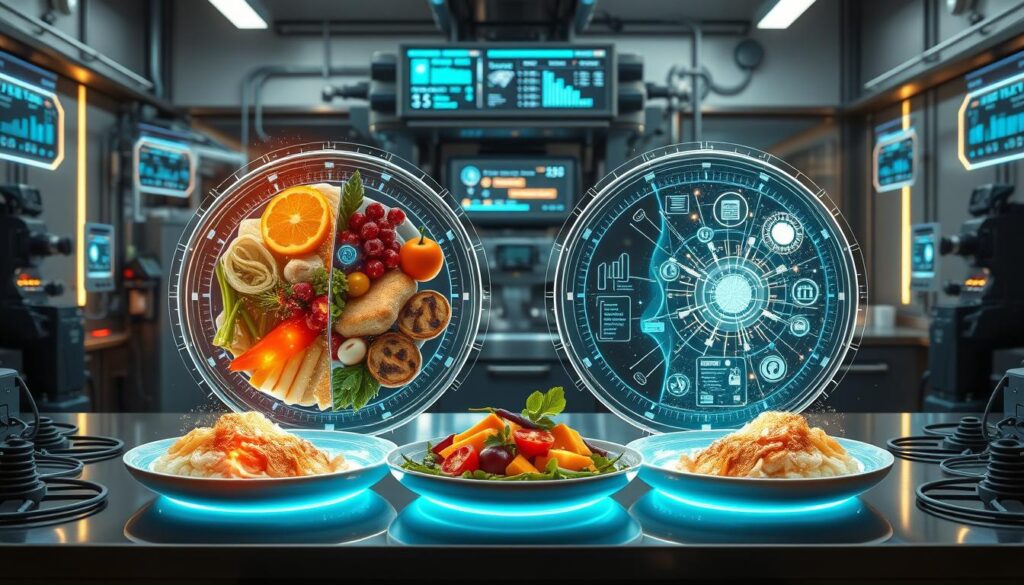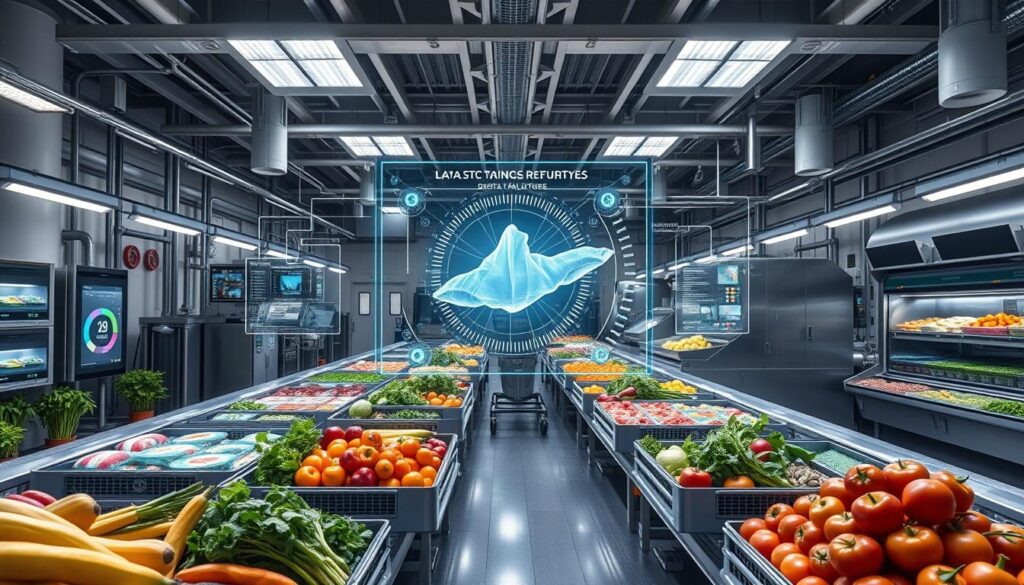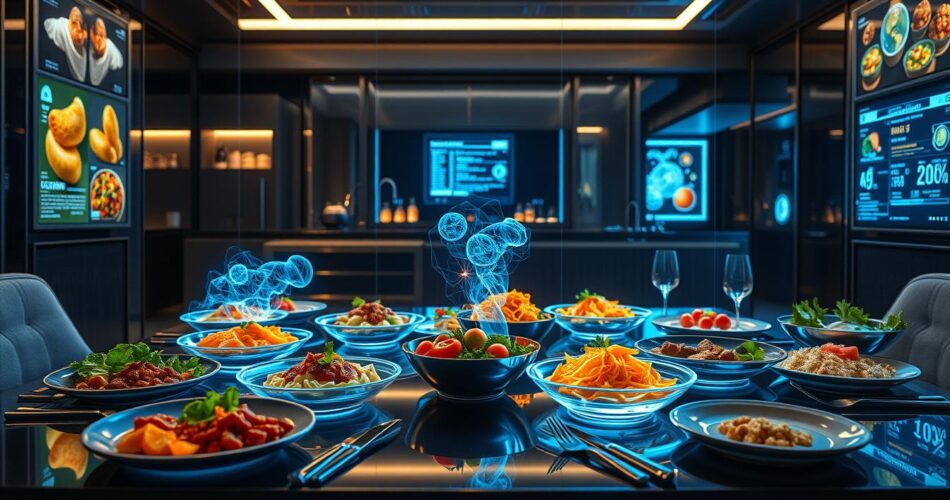I love food and the journey it takes from farm to table. The food industry is full of innovation and hard work. But, it faces big challenges like the pandemic, climate change, and wars.
Now, a new technology is changing how we make and eat food. It’s called digital twin meals. This tech creates virtual copies of food systems. It lets us watch, analyze, and improve food production in real time.
This new way is making food better and more personal. It’s also making cooking and eating more fun.
Key Takeaways
- Digital twin technology is revolutionizing the food industry by enabling real-time monitoring, simulation, and optimization of production processes.
- Virtual food modeling and simulation can enhance meal planning, personalized dietary analysis, and AI-powered meal recommendations.
- Integrating digital twins with IoT, AI, and cloud computing can drive further advancements in food technology and sustainability.
- Digital twins can help reduce food waste by simulating optimal food conservation conditions and supply chain logistics.
- Overcoming data security and privacy concerns is crucial for wider adoption of digital twin technology in the food and beverage industry.
The Rise of Digital Twins in the Food Industry
A new innovation is changing the food technology world – digital twins. These virtual models of real assets or processes offer real-time monitoring and analysis. They are changing how the food and beverage industry works.
What are Digital Twins?
Digital twins are virtual models that mirror their physical counterparts. They give deep insights into how systems perform and behave. In the food industry, this tech can be used from farm to table.
Applications of Digital Twins in Food Production
- In agriculture, digital twins can simulate crop growth and optimize resource use. They help farmers make better decisions to boost productivity and sustainability.
- In food processing plants, digital twins monitor equipment and analyze data. They find ways to improve efficiency and product quality.
- In distribution and logistics, digital twins track product movements. They optimize supply chains and ensure timely delivery to meet demand.
Digital twins offer real-time insights. They help food manufacturers make data-driven decisions. This leads to production optimization and better food manufacturing processes.
“Digital twins are revolutionizing the food industry by providing unprecedented visibility and control over every aspect of the production process. From farm to table, this technology is unlocking new levels of efficiency, sustainability, and quality.”
Benefits of Adopting Digital Twin Technology
Digital Twin technology brings many benefits to food and beverage companies. It creates virtual copies of production systems. This gives real-time insights into operations, helping make quick decisions and solve problems.
This technology helps with predictive maintenance. It cuts down on downtime and reduces the cost of equipment failures.
Predictive Maintenance and Reduced Downtime
Digital Twins use data analytics and machine learning to spot issues early. This lets food producers plan maintenance and repairs ahead of time. It keeps equipment running longer and reduces downtime.
This approach saves money and boosts competitiveness. It’s a big win for food producers.
Optimized Processes and Improved Efficiency
Digital Twins offer insights that help food manufacturers improve their processes. They make decisions based on data, finding ways to use resources better. This leads to better product quality and less waste.
It also means big savings and a stronger market position. Food producers become more competitive.
“Digital Twins have shown the potential to accurately predict short and long-term responses to diets, thereby improving patient understanding, motivation, adherence, and health outcomes.”
Challenges in Implementing Digital Twin Solutions
The food and beverage industry sees great potential in Digital Twin technology. Yet, several challenges must be tackled when adopting this solution. Data security and privacy are top concerns, as handling sensitive production data poses big cybersecurity risks. Also, making Digital Twins work with existing systems can be tough.
Scalability and the cost of setting up Digital Twins are big hurdles, especially for small companies. They often find it hard to afford the initial investment. The lack of people skilled in Digital Twin technology adds to the problem.
- Data security and privacy concerns
- Interoperability challenges between systems and devices
- Scalability limitations and high implementation costs
- Shortage of technical expertise and knowledge in Digital Twin development
To tackle these issues, companies need a detailed plan. They must focus on data security, system integration, and cost. Working with tech providers and experts can help fill the knowledge gap. This way, they can create solutions that fit the food and beverage industry’s needs.

“The successful implementation of Digital Twin technology requires a thoughtful and well-planned approach, addressing both technical and organizational hurdles.”
By facing these challenges, food and beverage companies can fully benefit from Digital Twin technology. They can improve their operations, enhance product quality, and grow sustainably in a competitive market.
digital twin meals: Enhancing Meal Planning and Personalization
Digital twin meals are changing how we think about food and health. They create virtual models of our bodies and how we eat. This lets doctors give us meal plans that really fit our needs.
Virtual Food Modeling and Simulation
Digital twin tech lets us see how food works with our bodies. Doctors can test how we react to different foods. They consider our age, gender, and health.
This helps find out if our diet is missing something. It shows how we can improve our eating habits.
Personalized Dietary Analysis and Recommendations
Digital twin tech uses lots of data to give us detailed diet plans. It knows our metabolism and what we need to eat. This helps us make better food choices.
It’s a big step towards better health. Digital twin meals are making nutrition more personal. They help us live healthier lives.
“The digital twin AI provides deeply individualized insights, such as informing a member when they are 14 days away from eliminating a medication.”
The Future of Digital Twins in Food Technology
The food and beverage industry is moving towards digital transformation. Digital twin technology is becoming more promising. The mix of IoT, AI, and cloud computing will bring new ideas and chances for digital twins in the food supply chain.
Integration with IoT, AI, and Cloud Computing
Combining digital twin tech with IoT, AI, and cloud computing will change the food industry. It connects real and virtual worlds. This lets companies use data to improve operations, efficiency, and product quality.
- IoT sensors in equipment and supply chains send data to digital twins. This helps predict maintenance and cuts downtime.
- AI looks at this data, finds patterns, and suggests ways to better processes. This boosts productivity and cuts waste.
- Cloud computing hosts and manages digital twin models. This makes them available to all businesses in the industry 4.0 world.
As companies focus on digital transformation and industry 4.0, digital twin tech will spread in the food industry. It will be used from production to retail.
| Future Trends | Impact on Digital Twins in Food Technology |
|---|---|
| Increased integration of VR/AR with digital twins | Users get immersive experiences to improve production processes |
| Scalable digital twins for smaller businesses | Help with crop yield modeling, supply chain optimization, and more in various industries |
| Standardization and interoperability | Make digital twins work together smoothly and lower costs |
| Enhanced cybersecurity measures | Add real-time anomaly detection and advanced encryption to protect data |
| Sustainable development applications | Help create environmentally friendly structures, energy systems, and transportation networks |
The food industry is getting ready to use digital twin technology more. This will lead to better efficiency, sustainability, and personalization in the food world.
Digital Twins in Food Waste Reduction
In the United States, food waste is a huge problem. About 30-40% of the food we produce is thrown away each year. This waste costs over $161 billion. Digital Twins are a new way to fight this problem. They use simulations to cut down on waste and make food production better.
Simulating Food Conservation Conditions
Legumbres Tierrina Vaqueira, a small food company, teamed up with Up Intelligence. They used digital twinning technology in their work. This helped them understand how to store food better, leading to less waste and more money.
Digital twins and biosensors are changing the food world. They make food safer and the supply chain more efficient. With these tools, we can track food in real time, predict problems, and plan better. This means less waste and safer food for everyone.
| Key Benefits of Digital Twins in Food Waste Reduction | Impact |
|---|---|
| Predictive Maintenance and Reduced Downtime | Ensures continuous food production and minimizes waste due to equipment failures |
| Optimized Processes and Improved Efficiency | Leads to cost savings, higher yields, and reduced environmental impact |
| Simulation of Food Conservation Conditions | Enables better planning, less waste, and higher product quality |
With digital twins, the food industry can cut down on waste and make things better. This is a big step towards a greener and more efficient future.

Case Studies: Successful Implementations of Digital Twins
Many companies in the food industry are seeing big wins with digital twin technology. Let’s look at some examples that show how digital twins can change the game.
In Hungary, Mirelite Mirsa, a company that makes quick-frozen veggies, fruits, and pasta, joined a program to boost food safety. They added smart sensors to their veggie blancher. This lets them watch and control temperature, humidity, and more in real-time.
This move helped Mirelite Mirsa keep food safe and cut down on waste. It also made their operations more efficient and saved them money.
| Company | Industry | Digital Twin Application | Key Benefits |
|---|---|---|---|
| Mirelite Mirsa | Food Production | Monitoring and controlling critical factors in the vegetable blancher | Enhanced food safety, reduced spoilage, improved efficiency, and cost savings |
| Siemens | Manufacturing | Leveraging digital twins in various manufacturing processes | Up to 30% reduction in operational costs and 50% reduction in time-to-market |
| SMEs (Small and Medium Enterprises) | Cross-Industry | Accelerating digital transformation efforts due to the COVID-19 pandemic | Improved efficiency, adaptability, and value delivery to customers |
Siemens, a big name in manufacturing, also saw huge gains with digital twins. They cut their costs by up to 30% and sped up their products by 50%.
Small and medium-sized businesses (SMEs) in the food industry have also benefited a lot. The COVID-19 pandemic pushed them to adopt digital twins quickly. This helped them work better, adapt to new tech, and serve their customers more effectively.
These stories highlight the big advantages of digital twin case studies in the food industry applications. They show how these technologies can lead to real success.
Overcoming Data Security and Privacy Concerns
The food and beverage industry is embracing digital twin technology. But, it faces big challenges in data security and privacy. Companies must protect sensitive production data to gain trust in this technology.
To tackle these issues, food and beverage companies need strong data protection plans. They should also have strict access controls and follow all relevant laws. Using blockchain technology can help make data more traceable and secure.
But, storing medical records on blockchain in plain text could be risky. It might leak private information. Companies must use good encryption to keep data safe while still being accessible.
Blockchain’s efficiency is also a worry. It could slow down digital twin systems. Finding the right balance between security, privacy, and performance is key.
By solving these problems, food and beverage companies can fully use digital twin technology. This can improve efficiency, predict maintenance needs, and reduce risks. It also keeps sensitive information safe.
| Benefit | Description |
|---|---|
| Improved asset performance | Real-time monitoring and predictive maintenance |
| Enhanced operational efficiency | Optimized processes and resource allocation |
| Risk mitigation and safety management | Real-time hazard analysis and emergency simulations |
| Data-driven decision-making | Performance analytics and scenario planning |
But, using digital twin technology in the food and beverage industry has its own challenges. There are skill gaps, resistance to change, and legal hurdles. Also, the cost of starting and keeping up with this technology can be a big obstacle.
“Cybersecurity challenges are a significant concern for digital twin technologies due to vulnerabilities to cyber-attacks. The sensitivity and intellectual property representation in digital twins make them attractive targets for cybercriminals seeking to disrupt businesses and access sensitive information.”
Conclusion
The digital twin revolution is changing the food and beverage industry. It brings new ideas, better efficiency, and more sustainability. Companies can now make virtual copies of their assets and processes. This lets them understand their operations better and offer more personalized experiences to customers.
The mix of IoT, AI, and cloud computing is making digital twin technology more common. This technology is key for success in the food industry. It helps companies become more sustainable, efficient, and focused on what customers want.
Using digital twin solutions can lead to many benefits. It can help with predictive maintenance and reduce downtime. It also makes processes better and more efficient. Plus, it has the power to change how we plan meals, reduce food waste, and transform the industry.
As digital twin technology gets better, it will shape the future of food. It will change how we make, distribute, and eat food. This is a big change for the food industry.
